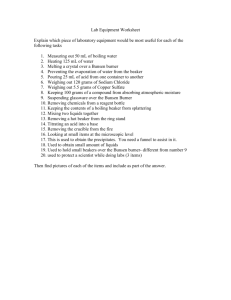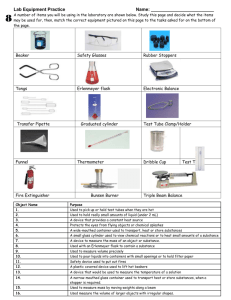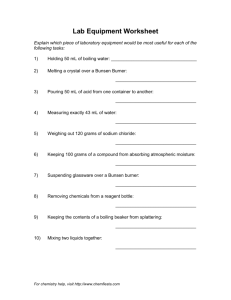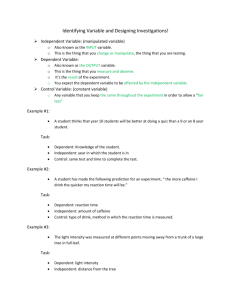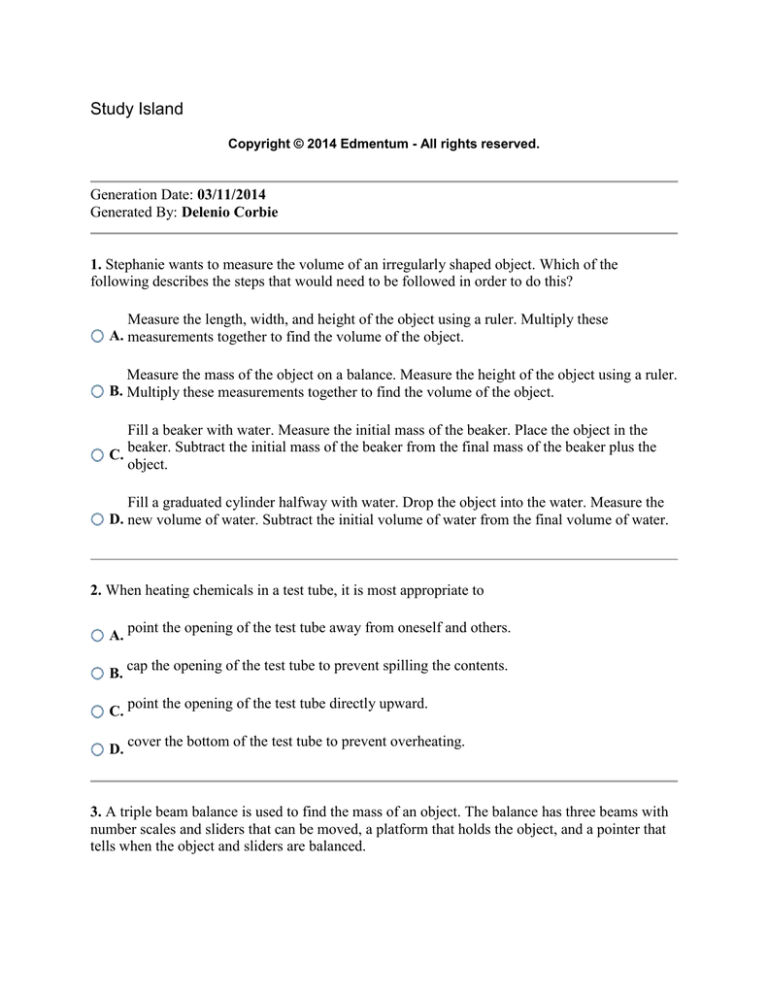
Study Island
Copyright © 2014 Edmentum - All rights reserved.
Generation Date: 03/11/2014
Generated By: Delenio Corbie
1. Stephanie wants to measure the volume of an irregularly shaped object. Which of the
following describes the steps that would need to be followed in order to do this?
Measure the length, width, and height of the object using a ruler. Multiply these
A. measurements together to find the volume of the object.
Measure the mass of the object on a balance. Measure the height of the object using a ruler.
B. Multiply these measurements together to find the volume of the object.
Fill a beaker with water. Measure the initial mass of the beaker. Place the object in the
beaker. Subtract the initial mass of the beaker from the final mass of the beaker plus the
C.
object.
Fill a graduated cylinder halfway with water. Drop the object into the water. Measure the
D. new volume of water. Subtract the initial volume of water from the final volume of water.
2. When heating chemicals in a test tube, it is most appropriate to
A.
B.
C.
D.
point the opening of the test tube away from oneself and others.
cap the opening of the test tube to prevent spilling the contents.
point the opening of the test tube directly upward.
cover the bottom of the test tube to prevent overheating.
3. A triple beam balance is used to find the mass of an object. The balance has three beams with
number scales and sliders that can be moved, a platform that holds the object, and a pointer that
tells when the object and sliders are balanced.
In order to use the balance, an object is placed on the platform. Then, the sliders on the beams
are moved to indicate the mass in hundreds, tens, and ones (and tenths) until
A. the pointer lines up with the zero mark.
B. the pointer is at the bottom and the object is at the top.
C. the pointer is at the top and the object is at the bottom.
D. the pointer and the mass are at zero.
4. Anita has a device for collecting weather data, similar to the one shown below.
Image courtesy of NOAA
As air passes by the blades, they spin, and the rate at which they spin is recorded. This device is
known as _______, and it is used to record _______.
A. an anemometer; wind speeds
B. a barometer; wind speeds
C. an anemometer; humidity
D. a barometer; humidity
5. A barometer is used to measure air pressure or a change in pressure readings. In order to
measure an air pressure change, the set pointer is placed _______ the reading pointer. Then, the
difference in pressure can be read after a certain amount of time by determining how much the
reading pointer has moved.
A. directly opposite of
B. on top of
C. to the left of
D. to the right of
6. There are many technologies that help people with disabilities. Don has trouble seeing long
distances and hearing very well. Which adaptive technologies would help him best?
A. glasses and a hearing aid
B. a prosthetic device and a wheelchair
C. braces and a prosthetic device
D. glasses and a walker
7. Which of the following tools is used to observe objects that are very far away?
A. a anemometer
B. a telescope
C. a hand lens
D. a microscope
8. Fred has a glass of water. Which of the following tools could he use to measure the volume of
water he has in the glass?
A. a metric ruler
B. a triple beam balance
C. a spring scale
D. a graduated cylinder
9. Nancy would like to find out how air temperature affects the rate of evaporation of water.
Which of the following tools should Nancy include in her experiment’s design?
A. spring scale and hand lens
B. meter stick and balance
C. stopwatch and forceps
D. thermometer and graduated cylinder
10. Angela has an apple. Which of the following tools could she use to measure the length of the
apple from top to bottom?
A. a metric ruler
B. a graduated cylinder
C. a thermometer
D. a spring scale
11. Some materials, especially unknown objects, are dangerous to handle with bare hands.
Which technological advance allows scientists to handle these objects enough to feel their
properties while still protecting their hands?
A. petri dishes
B. rubber gloves
C. beakers
D. forceps
12. Germaine wants to know exactly how acidic lemon juice is. Which of these can tell him the
pH most precisely?
A. indicator solution
B. red cabbage juice
C. pH paper
D. pH probe
13. Sachiko wants to measure the temperature of ice water in a beaker. The thermometer she will
be using is at room temperature. After she places the thermometer in the beaker, what should she
do to obtain the most accurate measurement?
A.
B.
C.
D.
14.
Take the reading on the thermometer immediately.
Wait until the water warms to room temperature, then take the reading on the thermometer.
Take the reading immediately after the mercury level in the thermometer becomes stable.
Wait five seconds, then take the reading on the thermometer.
Wendy wants to know which colors of light are emitted by her flashlight. Which tool could help
her?
A. a laser pointer
B. an anemometer
C. a spectroscope
D. a psychrometer
15. When there is a lot of water vapor in the air, the weather can feel warmer or colder than it
really is. What tool is used by meteorologists to measure the relative humidity?
A. barometer
B. hygrometer
C. thermometer
D. rain gauge
16. Space telescopes, including the Hubble Space Telescope shown below, have made it possible
to look much farther and deeper into space than traditional, land-based telescopes ever could.
This image is courtesy of NASA.
Why are optical space telescopes able to see deeper into outer space than land-based optical
telescopes?
A. because they look through the Earth's atmosphere
B. because they are above the Earth's atmosphere
C. because they are larger than land-based telescopes
D. because they are smaller than land-based telescopes
17. Betty is studying vein patterns in leaves. Which of the following tools could help Betty
examine the leaves' veins in greater detail?
A. a hygrometer
B. a compass
C. a hand lens
D. a graphing calculator
18. Ramone was boiling a beaker of water on a ring stand over the open flame of a bunsen burner
when some of the water bubbled over and extinguished the flame.
What should Ramone immediately do next?
A. He should notify his teacher.
B. He should turn off the gas.
C. He should remove the beaker from the ring stand.
D. He should try to reignite the bunsen burner.
19. With the invention of the microscope, scientists became able to see more details of very
small objects, such as cells. Now, many of the inner particles and workings of cells are better
understood.
The invention of the microscope and its use in studying cells show that technology
A. can contribute to and increase scientific knowledge.
B. makes scientific knowledge unnecessary.
C. has no effect on the gain of scientific knowledge.
D. hinders the development of scientific knowledge.
20. Select the correct sequence of steps for lighting a Bunsen burner.
A. Apply the spark above the barrel of the Bunsen burner.
B. Open the gas adjustment at the base of the Bunsen burner.
C. Connect the burner hose to the gas outlet.
D. Open the gas valve on the gas outlet.
A. D, C, A, B
B. C, B, D, A
C. C, D, B, A
D. C, D, A, B
Answers
1. D
2. A
3. A
4. A
5. B
6. A
7. B
8. D
9. D
10. A
11. B
12. D
13. C
14. C
15. B
16. B
17. C
18. B
19. A
20. C
Explanations
1. In order to measure the volume of an irregularly shaped object, it is necessary to use the water
displacement method. In this method, you must...
fill a graduated cylinder halfway full with water,
measure the initial volume of water by looking at the bottom of the meniscus,
drop the object into the water,
measure the final volume of water by looking at the bottom of the meniscus,
subtract the initial volume of water from the final volume of water to determine the
volume of the object.
2. When heating chemicals in a test tube, it is most appropriate to point the opening of the test
tube away from oneself and others.
Holding the test tube straight up and down would actually increase the chance of the contents
bubbling over. Never heat a container that has a tight cap. The container could explode.
3. In order to use the balance, an object is placed on the platform. Then, the sliders on the beams
are moved to indicate the mass in hundreds, tens, and ones (and tenths) until the pointer lines
up with the zero mark. Finally, the mass is read from the beams.
4. Devices like the one pictured are called anemometers, and they are used to record wind
speeds. Regularly monitoring wind speeds helps scientists to forecast changes in weather.
5. When using a barometer to measure a change in air pressure, the set pointer is placed on top
of the reading pointer. Then, if the reading pointer changes position, the change in pressure can
be determined.
6. Different adaptive technologies are suited for different disabilities. Somebody who has lost a
limb would benefit from a prosthetic device (artificial arm or leg) or wheelchair. Somebody who
has trouble walking would benefit from a walker, wheelchair, or leg braces. Somebody who
can’t see well can use glasses or contacts. Somebody who can’t hear well can often benefit from
a hearing aid.
7. A telescope makes objects that are very far away appear larger. This makes them easier to
observe. Objects like stars and planets are often observed through telescopes.
8. A graduated cylinder is used to measure the volume of a liquid. This would be the best tool
to measure the volume of water he has in the glass.
9. To test the effects of air temperature on the rate of evaporation of water, Nancy could design
an experiment in which she pours a certain amount of water into graduated cylinders, places the
cylinders in rooms of different temperatures, and returns after a certain amount of time to
measure how much liquid water is left in the cylinders. In order to do this she would need a
thermometer and a graduated cylinder.
10. A metric ruler is used to measure the length of an object. This would be the best tool to
measure the length of the apple from top to bottom.
11. Rubber gloves allow scientists to handle many objects that are too dangerous to be handled
by bare hands. However, there are still many objects that should not be handled, even with
rubber gloves. Also, some people are allergic to rubber and must use other kinds of gloves.
12. A pH probe connects to a computer to display and record the numerical value for the pH of a
solution. Indicator solutions, red cabbage juice, and pH paper can only give an approximate pH
value.
A pH meter can also give the numerical value of a solution's pH, but it does not need to be
connected to a computer.
13. After Sachiko places the room-temperature thermometer in the beaker of ice water, the
mercury level will immediately begin to drop. It will take several seconds for the thermometer to
adjust to the new temperature. To obtain the most accurate reading, she should watch the
mercury level closely and take the reading immediately after the mercury level has become
stable.
14. A spectroscope is a tool that divides light into the different colors that make it up. Most light
sources—including light bulbs, flashlights, and the Sun—emit many different colors, but not all
colors. A spectroscope can help an observer determine which colors are released by the light
source and which colors are not.
15. The relative humidity an important factor used to predict the weather. The combination of
humidity, the air temperature, and the barometric pressure help predict whether precipitiaton will
fall.
Meteorologists measure the realtive humidity using a hygrometer.
16. Optical telescopes have been used by astronomers for hundreds of years. Galileo first used an
optical telescope to observe Jupiter and the Moon in the early 1600s. But images created by landbased optical telescopes have always been blurred by the Earth's atmosphere.
The air surrounding the Earth bends and scatters light coming from stars, making the stars appear
to "twinkle." Space telescopes, such as NASA's Hubble Space telescope, are above Earth's
atmosphere. This vastly increases their ability to see great distances with incredible detail.
17. Betty could us a hand lens to examine the leaves' veins in greater detail. Hand lenses make
objects close behind them appear larger. If Betty uses a hand lens, it will be easier for her to
observe the patterns she is studying.
18. If the flame of a bunsen burner goes out for any reason, the gas should immediately be turned
off. If this procedure is not followed, gas could build up in the classroom and cause a fire or
explosion. Students may also become ill from inhaling the gas.
19. The invention of the microscope and its use in studying cells show that technology can
contribute to and increase scientific knowledge.
When new technologies are invented, they often aid scientists in discovering new information or
altering a present view of a scientific topic.
20. The sequence of steps for lighting a Bunsen burner is as follows:
1. Connect the burner hose to the gas outlet.
2. Open the gas valve on the gas outlet.
3. Open the gas adjustment at the base of the Bunsen
burner.
4. Apply the spark above the barrel of the
Bunsen burner.

